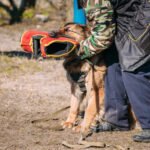Training your dog to protect you and your home from potential intruders is an important aspect of responsible pet ownership. While the idea of a dog attacking someone may seem intimidating, training your pup to respond appropriately in dangerous situations can actually help prevent harm and ensure the safety of everyone involved.
This article will guide you through the process of training your dog to recognize threats, respond with controlled aggression, and ultimately provide you with peace of mind when it comes to your home security.
As a responsible pet owner, it is crucial to understand the importance of proper training techniques when it comes to teaching your dog how to protect you against potential intruders. Training should emphasize control, obedience, and discernment rather than promoting uncontrolled aggression or harm towards others. By teaching your dog to attack in a controlled manner, you can create an effective deterrent that helps keep intruders at bay while minimizing risks for all parties involved.
Before embarking on protection training for your furry companion, it is essential to assess if they are suitable for this specialized type of training. Not all dogs have the temperament or physical attributes necessary for protection work.
Factors such as breed traits, temperament testing, and overall health should be taken into consideration beforehand. It is important not to force a dog into this type of training if they are not well-suited for it, as doing so could result in unintended consequences.
In the following sections of this article, we will delve into specific aspects of training your dog for protection purposes. From building trust and establishing a strong bond with your canine friend to teaching them basic obedience commands as a foundation for attack training, each step plays a vital role in ensuring success in preparing your pup for potential threats.
So let’s begin this journey together on empowering your beloved pet with the skills necessary to safeguard your home and loved ones effectively.
Understanding the Importance of Proper Training Techniques
When it comes to training your dog to protect your home and loved ones, understanding the importance of proper training techniques is crucial. A well-trained protection dog can provide an extra layer of security and peace of mind for you and your family. However, it’s essential to approach this training responsibly and ethically, focusing on building a strong foundation of obedience and trust with your dog.
Proper training techniques ensure that your dog is equipped with the necessary skills to assess threats accurately and respond appropriately. It involves teaching your dog bite inhibition, impulse control, and the ability to differentiate between potential dangers and everyday situations. By using rewards-based methods and positive reinforcement, you can establish clear communication with your dog, promoting a healthy bond based on mutual trust.
One important aspect of proper training techniques is avoiding any harsh or physically harmful methods. Aggressive or abusive approaches can not only be inhumane but also counterproductive. Using force or intimidation may escalate aggression in dogs or even cause fear-related behavior issues.
Instead, focus on reward-based methods such as clicker training or using treats as motivators when teaching new commands or behaviors. Positive reinforcement not only helps build a stronger relationship between you and your dog but also makes the learning process more enjoyable for both parties.
| Statistic | Data |
|---|---|
| Percentage of trainers using positive reinforcement in their programs | 88% |
| Percentage reduction in aggression after positive reward-based training | 49% |
| Average time for a working breed dog to reach advanced protection training level | 12-18 months |
Proper training techniques are essential not just for the effectiveness of protection training but also for the well-being and happiness of your dog. With a solid understanding of these techniques, you will set the foundation for a successful and safe protection dog training journey.
Assessing if Your Dog is Suitable for Protection Training
Before embarking on the journey of training your dog to protect your home and loved ones, it is crucial to assess if your dog is suitable for protection training. Not all dogs possess the temperament, physical attributes, or instincts necessary for this specialized training. It is important to consider these factors to ensure the safety and success of both you and your dog.
One of the key aspects to evaluate when assessing your dog’s suitability for protection training is their temperament. Protection-trained dogs need to be confident, stable, and highly trainable. They should not exhibit fear or aggression towards people or other animals unless commanded to do so. A well-socialized dog that is friendly with strangers but has a strong protective instinct can be a good candidate for protection training.
Additionally, physical attributes play a significant role in assessing a dog’s suitability for protection training. Dogs that are large, agile, and possess good muscle tone tend to excel in this type of training. Breeds like German Shepherds, Belgian Malinois, Rottweilers, Dobermans, and Dutch Shepherds are commonly selected for their natural protective instincts and physical capabilities.
To further determine if your dog is suitable for protection training, it can be beneficial to consult with a professional trainer or behaviorist experienced in working with protection dogs. They can assess your dog’s temperament, drive levels, and physical abilities more accurately. If necessary, they may also recommend conducting specific tests such as an aggression assessment or temperament test.
Overall, ensuring that you have a suitable candidate before commencing protection training sets the foundation for success. By carefully evaluating your dog’s temperament and physical attributes alongside professional guidance if needed ensures that you are providing appropriate training while prioritizing safety for everyone involved.
| Factor | Considerations |
|---|---|
| Temperament | A confident, stable, and trainable dog without fear or aggression towards people or animals. |
| Physical Attributes | Large, agile, and well-built dogs with good muscle tone. |
| Professional Assessment | Consulting with an experienced trainer or behaviorist to evaluate temperament, drive levels, and physical abilities. |
Building Trust and Establishing Strong Bond with Your Dog
Building a strong bond and establishing trust with your dog is crucial before moving on to any advanced training, especially when it comes to protection training. Your dog needs to see you as their leader and be confident in your ability to keep them safe. Here are some steps you can take to build trust and establish a strong bond with your dog:
- Spend Quality Time Together: Dedicate regular quality time for bonding activities such as going on walks, playing games, or simply relaxing together. This will help create positive associations between you and your dog.
- Consistency and Routine: Dogs thrive on consistency and routine, so establish a daily routine that includes feeding, exercise, training sessions, and rest times. By being consistent, your dog learns what is expected of them and feels secure in their environment.
- Positive Reinforcement: Use positive reinforcement techniques such as treats, praise, and affection to reward desired behaviors. This fosters a positive association between training sessions and the interaction with you.
- Socialization: Expose your dog to various environments, people, animals, sounds, and objects from an early age. This helps them become well-adjusted and confident when encountering new situations.
- Clear Communication: Learn how to effectively communicate with your dog using body language, tone of voice, and consistent cues or commands. This clarity helps build trust as your dog understands what is expected of them.
By focusing on building trust and establishing a strong bond with your dog through these methods, you are laying the foundation for successful protection training. Remember that protection training should always prioritize safety for everyone involved – both humans and dogs – while providing a sense of security for you and your loved ones at home.
Basic Obedience Training as a Foundation for Attack Training
Establishing a Strong Foundation
Before diving into attack training, it is crucial to establish a strong foundation of basic obedience training for your dog. Basic obedience provides the necessary building blocks to ensure that your dog understands and responds to your commands reliably. This foundation not only enhances the safety and control you have over your canine companion but also forms the basis for more advanced training techniques.
Key Commands to Focus on
There are several key commands that should be mastered during basic obedience training as they will lay the groundwork for successful attack training later on. The first and most important command is “sit,” which helps your dog learn impulse control. “Stay” is another vital command, teaching your dog to remain in one place until given further instructions. Additionally, “heel” ensures that your dog walks calmly and attentively by your side instead of pulling or lunging forward.
Consistency and Positive Reinforcement
Consistency is key when it comes to basic obedience training. Ensure that all family members are following the same rules and using consistent cues and gestures for each command. This consistency helps avoid confusion for your dog and reinforces their understanding of each command.
Positive reinforcement is an essential element of basic obedience training. Rewarding desired behaviors with treats, praise, or playtime strengthens the bond between you and your dog while making learning more enjoyable for them. Be sure to use rewards immediately after the desired behavior occurs to reinforce the connection between the action and reward.
By establishing a strong foundation of basic obedience training, you are setting both yourself and your dog up for success in any further specialized training like attack training. Once these fundamental skills are firmly embedded, you can move on to more specific techniques aimed at recognizing threats and protecting your home effectively.
Teaching Your Dog to Recognize Threats – Identifying Intruders
Teaching your dog to recognize threats and identify intruders is a crucial aspect of training them for protection. By developing this skill, you can ensure that your dog is able to distinguish between friendly visitors and potential threats, allowing them to act accordingly in different situations. Here are some effective techniques to teach your dog how to recognize threats and identify intruders:
- Socialization: Exposing your dog to various people, sounds, and environments from an early age will help them become more comfortable and confident in different situations. Arrange controlled interactions with friends and family members pretending to be strangers or intruders. Reward your dog with treats and praise for displaying alertness towards unfamiliar individuals.
- Scent Training: Dogs have a remarkable sense of smell, which can be utilized to identify intruders by scent. Introduce your dog to the scents of familiar household members and then gradually introduce scents of other individuals who may visit the house regularly. Use scent-detection games or toys to enhance their ability to locate specific scents associated with potential threats.
- Body Language Recognition: Teach your dog to understand body language cues that indicate a threat or aggression. Train them to identify certain postures or movement patterns, such as raised voices, tense body language, or sudden gestures that may signal potential danger. Practice these cues during obedience training sessions, rewarding your dog for correctly recognizing these signals.
- Verbal Commands: Teach your dog specific verbal commands that cue them to recognize potential threats or intruders. For example, use the command “watch” or “alert” when someone approaches the door without permission. Pair these commands with physical stimuli like pointing towards the source of interest while repeating the command consistently.
By following these techniques and consistently practicing them in various scenarios, you can train your dog to recognize threats and identify potential intruders effectively. Remember never to encourage aggressive behavior but instead focus on providing a safe environment for your dog and loved ones. It is essential to consult with professional trainers or behaviorists for additional guidance to ensure a well-rounded training program focused on protection and safety.
Positive Reinforcement Techniques for Teaching Attack Commands
Introduction to Positive Reinforcement Techniques
When training your dog to protect your home, it is crucial to use positive reinforcement techniques to teach attack commands. Positive reinforcement focuses on rewarding desired behaviors rather than punishing unwanted ones. By utilizing this approach, you can create a strong foundation of trust, obedience, and responsiveness in your dog.
Choosing the Right Rewards
One of the keys to successful positive reinforcement training is selecting the correct rewards for your dog. It is essential to identify what motivates your specific canine companion. For most dogs, treats are a popular choice, but some may prefer praise or playtime as rewards. Experiment with different options and observe which ones your dog responds best to.
When using treats as rewards, it is important to choose high-value treats that your dog finds irresistible. These treats should be reserved solely for training purposes to maintain their effectiveness. Additionally, consider the size of the treat – too large of a reward may distract your dog from further training, while too small of a reward may not be enticing enough.
Creating an Association with Attack Commands
To develop an association between attack commands and specific actions, start by using verbal cues such as “guard” or “protect.” Pair these commands with hand signals for better understanding. Begin in a controlled environment where distractions are minimal.
After giving the command and signal, wait for your dog to exhibit any form of protective behavior towards you or an object representing an intruder (such as a stuffed toy). As soon as your dog displays even the slightest progress towards protecting or defending, reward them immediately with praise and their chosen reward.
By consistently reinforcing this association between attack commands and desirable responses, your dog will learn to understand and execute these commands effectively in real-life situations.
Pitfalls to Avoid
While using positive reinforcement techniques for teaching attack commands is highly effective, it is important to avoid certain common pitfalls. Avoid using punishment or harsh corrections when your dog doesn’t respond as desired, as this may damage the trust and bond you have established.
Additionally, be cautious not to unintentionally reward aggressive behavior towards strangers or acquaintances. Dogs should only exhibit protective behavior in genuine intruder situations. It is crucial to differentiate between a perceived threat and a harmless passerby.
Remember, the goal of training your dog to protect your home is not to encourage aggression but rather to ensure their obedience in critical situations. Positive reinforcement techniques will allow you to achieve this goal while maintaining a safe and controlled environment for both your dog and those around them.
Ensuring Safety and Liability
When training your dog to protect your home, it is crucial to consider the legal and ethical implications of such training. While having a well-trained protective dog can provide a sense of security, it is essential to prioritize safety and responsibility. This section will explore the legal and ethical considerations that should be taken into account when training your dog for protection purposes.
- Awareness of Applicable Laws: Different countries and jurisdictions may have specific laws governing the training and use of protection dogs. It is important to familiarize yourself with these laws to ensure compliance. Some countries require owners of protection dogs to register their animals or obtain special permits.
Additionally, there may be regulations regarding the level of force that can be used by a dog in protecting its owner or property. Understanding these laws will help prevent legal issues down the line. - Responsible Training Practices: When training your dog, it is vital to prioritize positive reinforcement techniques and avoid harsh methods or actions that could cause harm to others unnecessarily. Aggressive behavior towards individuals who are not posing a genuine threat can lead to serious consequences both for you as an owner and for your dog.
Responsible training practices focus on teaching the dog self-control, proper discernment between real threats and non-threatening situations, and clear understanding of boundaries. - Liability Concerns: Owning a protection dog comes with potential liability risks. If your trained dog bites or causes injury to someone without justifiable cause, you could be held legally accountable for damages or face lawsuits.
It is crucial to take steps to minimize these risks by ensuring that your dog is properly trained under professional guidance, socialized with other people in different settings, and always kept on leash or within secure boundaries when outside of your property.
By being aware of the legal requirements, maintaining responsible training practices, and addressing liability concerns associated with owning a protection dog, you can ensure that both you and your dog remain safe and within the bounds of the law. Remember, the primary purpose of training a protective dog is to create a safe environment for everyone and deter intruders, not to promote aggression or harm towards individuals.
Utilizing Professional Trainers and Resources for Advanced Training
Training your dog to protect your home and loved ones is a serious endeavor that requires the guidance and expertise of professional trainers. While basic obedience training lays the foundation, advanced training is necessary to ensure your dog can effectively respond in high-stress situations. Utilizing professional trainers and resources can greatly enhance your dog’s skills and provide you with the knowledge needed for successful training.
Professional trainers have extensive experience in protection training and can assess your dog’s temperament, capabilities, and suitability for advanced training. They understand the nuances of teaching dogs to respond appropriately to threats without compromising their safety or well-being. Trainers can tailor the training program specifically to your dog’s needs while ensuring a positive training environment.
Additionally, professional trainers have access to a variety of resources that can aid in advanced training. They are familiar with various techniques, tools, and equipment designed to help dogs develop their protection skills. These resources may include bite suits, decoy equipment, agility courses, and specialized exercises that simulate real-life situations. By utilizing these resources alongside expert guidance, you can ensure comprehensive and effective training for your dog.
To find a reputable trainer, consider seeking recommendations from local veterinarians or fellow dog owners who have successfully trained their dogs in protection work. It is essential to choose a trainer who emphasizes positive reinforcement techniques rather than punitive measures. Positive reinforcement not only builds trust between you and your dog but also enhances their overall enthusiasm and motivation during the training process.
Once you have selected a professional trainer, they will work closely with you to develop a personalized training plan based on both your goals as well as your dog’s abilities. Regular sessions will be scheduled to address specific areas of focus such as controlled aggression towards intruders or responding appropriately to different scenarios. The trainer will guide you through each step of the training process while providing valuable feedback on both you and your dog’s progress.
Real-Life Scenarios
Why Real-Life Scenarios are Beneficial
Simulating real-life intruder situations during training can be extremely beneficial in preparing your dog to protect your home and loved ones. By exposing your dog to realistic scenarios, you provide them with practical experience and help them develop the necessary skills to respond appropriately in a threatening situation. Real-life scenarios offer a heightened sense of urgency and mimic the unpredictability that may occur during an actual intrusion.
Creating Safe but Realistic Scenarios
When simulating intruder situations for training, it is crucial to prioritize safety for both you and your dog. It’s important to remember that the goal is not to incite aggression towards people but rather to train your dog to respond to potential threats responsibly. Here are some considerations when creating safe but realistic scenarios:
- Use professional assistance: Seek guidance from professional trainers or behaviorists who specialize in protection training. They can guide you on creating safe yet effective scenarios tailored specifically to your dog’s needs and abilities.
- Gradual exposure: Begin with low-intensity simulations and gradually increase the complexity of the scenarios as your dog becomes more confident and proficient in their training.
- Controlled environments: Start by conducting simulations in controlled environments such as an enclosed backyard or designated training areas. This provides a controlled setting where distractions can be minimized, ensuring the safety of anyone involved.
- Involve trusted individuals: During initial stages of training, involve familiar individuals who can play the role of an intruder under careful supervision. This helps your dog distinguish between familiar faces and true threats.
- Vary scenarios: Introduce a variety of scenarios that simulate different types of intrusions like forced entries, unexpected loud noises, or suspicious behavior outside the house. This helps develop your dog’s ability to recognize different threat cues and respond accordingly.
Building Confidence and Responsiveness
Real-life scenarios not only help train your dog to respond appropriately but also build their confidence. As your dog successfully navigates through these simulations, they become more assertive and responsive when faced with potential threats. By consistently reinforcing positive behavior during training, your dog will develop a strong sense of responsibility towards protecting their home and loved ones.
Remember, the primary goal of simulating intruder situations is to equip your dog with the skills and mindset to deter potential threats while maintaining safety for everyone involved. Providing appropriate guidance, training, and reinforcement will help them become reliable protectors without compromising their well-being or promoting aggression towards others.
Continual Training and Maintenance to Strengthen Your Dog’s Skills
Training your dog to protect you and your home from potential intruders is not a one-time task. It requires ongoing training and maintenance to ensure that your dog’s skills stay sharp and reliable. Consistent training sessions will reinforce their abilities, improve their response time, and keep them mentally and physically fit for the task at hand.
Regular practice is crucial for maintaining your dog’s protective instincts. Set aside designated times each week to work on reinforcement exercises. These can include scenarios such as simulated break-ins or having a person dress up in unfamiliar attire to mimic a potential threat. By consistently exposing your dog to these situations, they will become more confident and adept at identifying potential dangers.
In addition to practicing attack commands, it is important to continuously reinforce basic obedience training. This foundation is essential for your dog’s overall behavior, control, and safety during any situation. Regularly review commands such as sit, stay, come, and heel even when not directly working on protection training. This will help maintain discipline and ensure that your dog responds swiftly to your instructions when confronted with an intruder or other high-stress situations.
Don’t overlook the importance of physical exercise and mental stimulation in maintaining your dog’s skills. Physical activities like jogging or brisk walks can help release excess energy while promoting better focus. Engaging mental enrichment exercises such as puzzle toys or scent detection games will keep their mind sharp and strengthen their problem-solving abilities.
Lastly, continue socializing your dog with people (including strangers) and other animals regularly. This exposure helps teach them how to distinguish between harmless visitors and actual threats while also preventing aggression towards innocent individuals. Regular interactions with others in controlled environments encourage better discernment of potentially dangerous situations.
By committing to regular training sessions, reinforcing basic obedience, providing exercise opportunities, engaging in mental stimulation activities, and promoting positive socialization experiences, you can continually strengthen your dog’s protective skills. This ongoing dedication ensures their preparedness to safeguard your home and loved ones effectively. Remember, a well-trained dog is a valuable asset and an excellent deterrent, providing you with peace of mind in unsettling times.
Conclusion
In conclusion, training your dog to safeguard your home and loved ones is an important responsibility that can give you peace of mind and enhance the safety of your household. By utilizing proper training techniques and establishing a strong bond with your dog, you can develop their skills in recognizing threats and responding appropriately. Basic obedience training lays the foundation for advanced attack training, while positive reinforcement techniques can be used to teach attack commands effectively.
However, it is crucial to always prioritize safety and liability considerations. Before embarking on protection training, assess if your dog is suitable for this type of training and make sure to comply with legal and ethical standards. Consulting with professional trainers or accessing reliable resources can provide valuable guidance in this regard.
Lastly, continual training and maintenance are essential for strengthening your dog’s skills. Simulating real-life intruder scenarios helps them apply their training effectively in high-pressure situations. Remember that the goal is not promoting aggression towards others but equipping your dog to act as a deterrent or create a safe space when faced with potential threats.
In summary, by empowering your dog through appropriate training, you can enhance the security of your home and loved ones. It is imperative to approach protection training responsibly, prioritizing safety, ethics, and legality throughout the process. With consistent practice and ongoing maintenance, your well-trained dog can become a valuable asset in safeguarding your household.

Welcome to the blog! I am a professional dog trainer and have been working with dogs for many years. In this blog, I will be discussing various topics related to dog training, including tips, tricks, and advice. I hope you find this information helpful and informative. Thanks for reading!





